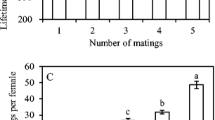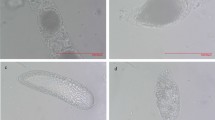Abstract
Thaumatotibia leucotreta (Meyrick) (Lepidoptera: Tortricidae) is a polyphagous insect pest native to sub-Saharan Africa. The larvae burrow into the fruit and feed on the pulp, thus inflicting huge direct (yield) and indirect losses (markets). Nevertheless, little is known about the mating frequency, behavior, and trade-off between fecundity and longevity of this pest. Therefore, this study aimed to determine the effect of mating status and frequency on fecundity, fertility, and female longevity of T. leucotreta; evaluate the trade-off between the female fecundity and longevity, and evaluate the spermatophore degradation in the bursa copulatrix. The first mating occurred 13 h on average after adult eclosion and the highest number of individuals were mated on the first-day post eclosion. Females mated frequently with an average of 6.3 mating occurrences. Fecundity was highest for females mated multiple times with the same male followed by those mated with different males. An increase in mating duration significantly increased the fecundity of females mated once with virgin males, while it decreased the fecundity of those mated once with the mated males. The number of eggs laid by females significantly increased with the increase in the number of matings and female longevity. The amount of resources invested by females for egg laying was thirty to seventy times higher than those used for survival, depending on the mating status. The spermatophore in bursa copulatrix was invisible 24 h after copulation. Our results contribute to a better understanding of the reproductive biology and demographic parameters of T. leucotreta. The findings of this study lay the foundation for the development of sound management strategies of this pest, such as the use of autodissemination technique, mating disruption, and sterile insect techniques.







Similar content being viewed by others
Data Availability
All prevalent data are available within the manuscript.
References
Adom M, Fening KO, Billah MK et al (2021) Pest status, bio-ecology and management of the false codling moth, Thaumatotibia leucotreta (Meyrick) (Lepidoptera: Tortricidae) and its implication for international trade. Bull Entomol Res 111:17–30
Altesor P, Horas VR, Arcia MP, Rossini C, Zarbin PH, González A (2010) Reproductive behavior of Crocidosema (=Epinotia) aporema (Walsingham) (Lepidoptera: Tortricidae): temporal pattern of female calling and mating. Neotrop Entomol 39:324–329
Arnqvist G, Nilsson T (2000) The evolution of polyandry: multiple mating and female fitness in insects. Anim Behav 60:145–164
Bakker AC, Campos LJ, Roessingh P, Menken SBJ (2011) The cost of mating: influences of life-history traits and mating strategies on lifespan in two closely related Yponomeuta species. Int J Zool 2011:1–8
Barclay HJ (2005) Mathematical models for the use of sterile insects. In: Dyck VA, Hendrichs J, Robinson AS (eds) Sterile Insect Technique. Principles and Practice in Area-Wide Integrated Pest Management. Springer, Dordrecht, The Netherlands, pp 147–174
Bateman AJ (1948) Intra-sexual selection in Drosophila. Heredity 2:349–368
Boggs CL (1990) A general model of the role of male-donated nutrients in female insects' reproduction. Am Nat 136:598–617
Burns JM (1968) Mating frequency in natural population of skippers and butterflies as determined by spermatophore counts. Proc Natl Acad Sci USA 61:852–859
Cingolani MF, Roggiero MF, Barakat MC, Liljesthröm GG (2020) Polyandry and trade-off between fecundity and longevity in female Dichelops furcatus (Hemiptera: Pentatomidae). Bull Entomol Res 110:155–160
Daiber CC (1980) A study of the biology of the false codling moth Cryptophlebia leucotreta (Meyr.): the adult and generations during the year. Phytophylactica 12:187–193
Drummond BA (1984) Multiple matings and sperm competition in the Lepidoptera. In: Smith RL (ed) Sperm competition and the evolution of animal mating systems. Academic, London, pp 291–370
Ehrlich AH, Ehrlich PR (1978) Reproductive strategies in the butterflies: I. Mating frequency, plugging, and egg number. J Kans Entomol Soc 51:666–697
EPPO (2013) Pest risk analysis for Thaumatotibia leucotreta. EPPO, Paris
Erichsen C, Schoeman AS (1994) Moth pests of avocados. South African Avocado Growers’ Association Yearbook 17:109–112
Foster SP, Harris MO (1997) Behavioral manipulation methods for insect pest-management. Annu Rev Entomol 42:123–146
Franco K, Jauset A, Castañé C (2011) Monogamy and polygamy in two species of mirid bugs:a functional-based approach. J Insect Physiol 57:307–315
Gullan PJ, Cranston PS (2014) The Insects: An outline of entomology, 5th Edition. John Wiley & Sons, Chichester, West Sussex UK. PP 603.
Haff R, Ovchinnikova I, Liang P et al (2020) X-Ray-based irradiation of larvae and pupae of the navel orangeworm (Lepidoptera: Pyralidae). J Econ Entomol 113:1685–1693
Karlsson B (1998) Nuptial gifts, resource budgets, and reproductive output in a polyandrous butterfly. Ecology 79:2931–2940
Lee MS, Albajes R, Eizaguirre M (2014) Mating behavior of female Tuta absoluta (Lepidoptera: Gelechiidae): polyandry increases reproductive output. J Pest Sci 87:429–439
Floriculture (2015) Kenyan pepper threatened by pest. http://www.florinews.com/index.php/past-featured-articles/50-featured-articlejuly-august-2015/170-kenyan-pepper-threatened-by-pest. Accessed 18 May 2021.
Malan AP, Von Diest JI, Moore SD, Addison P (2018) Control options for false codling moth, Thaumatotibia leucotreta (Lepidoptera: Tortricidae), in South Africa, with emphasis on the potential use of entomopathogenic nematodes and fungi. Afr Entomol 26:14–29
Mann T (1984) Spermatophores: development, structure, biochemical attributes and role in the transfer of spermatozoa. Zoophysiology 15:1–217
Mgocheki N, Addison P (2016) Investigating the validity of the species status of the false codling moth in South African deciduous fruit orchards using mating studies and mtDNA. Bull Entomol Res 106:598–605
Mkiga AM, Mohamed SA, du Plessis H, Khamis FM, Ekesi S (2019) Field and laboratory performance of false codling moth, Thaumatotibia leucotreta (Lepidoptera: Tortricidae) on orange and selected vegetables. Insects 10:63
Mkiga AM, Mohamed SA, du Plessis H, Khamis FM, Akutse KS, Ekesi S (2020) Metarhizium anisopliae and Beauveria bassiana: pathogenicity, horizontal transmission, and their effects on reproductive potential of Thaumatotibia leucotreta (Lepidoptera: Tortricidae). J Econ Entomol 113: 660-668.
Mkiga AM, Mohamed SA, du Plessis H, Khamis FM, Akutse KS, Nderitu PW, Niassy S, Muriithi BW, Ekesi S (2021) Compatibility and efficacy of Metarhizium anisopliae and sex pheromone for controlling Thaumatotibia leucotreta. J Pest Sci 94:393–407
Moore SD, Richards GI, Chambers C, Hendry D (2014) An improved larval diet for commercial mass rearing of the false codling moth, Thaumatotibia leucotreta (Meyrick) (Lepidoptera: Tortricidae). Afr Entomol 22:216–219
Moore S, Hattingh V (2012) A review of current pre-harvest control options for false codling moth in citrus in southern Africa. South African Fruit Journal 11:82–85
Mutyambai DM, Nyang’au IM, Onamu E, Kasina MJ, Nderitu JH, Mweke AN (2020) False codling moth, Thaumatotibia leucotreta (Meyrick) a new threat to horticulture industry: stakeholders’ perspectives on the status, impact, and management in Kenya. J Plant Dis Protect 127:799–804
O’Hara RB, Kotze DJ (2010) Do not log-transform count data. Methods Ecol Evol 1:118–122
Oberhauser KS (1992) Rate of ejaculate breakdown and intermating intervals in monarch butterflies. Behav Ecol Sociobiol 31:367–373
Odanga JJ, Mohamed S, Mwalusepo S et al (2018) Spatial distribution of Bactrocera dorsalis and Thaumatotibia leucotreta in smallholder avocado orchards along altitudinal gradient of Taita Hills and Mount Kilimanjaro. Insects 9:71
Outram I (1971) Aspects of mating in the spruce budworm, Choristoneura fumiferana (Lepidoptera: Tortricidae). Can Entomol 103:1121–1128
Ouye MT, Garcia RS, Graham HM, Martin DF (1965) Mating studies on the pink bollworm, Pectinophora gossypiella (Lepidoptera: Gelechiidae), based on presence of spermatophores. Ann Entomol Soc Am 58:880–882
Pérez-Staples D, Díaz-Fleischer F, Montoya P (2021) The sterile insect technique: success and perspectives in the Neotropics. Neotrop Entomol 50:172–185
Reguera P, Pomiankowski A, Fowler K, Chapman T (2004) Low cost of reproduction in female stalk-eyed flies, Cyrtodiopsis dalmanni. J Insect Physiol 50:103–108
Rhainds M (2010) Female mating failures in insects. Entomol Exp Appl 136:211–226
Seth RK, Kaur JJ, Rao DK, Reynolds SE (2002) Sperm transfer during mating, movement of sperm in the female reproductive tract, and sperm precedence in the common cutworm Spodoptera litura. Physiol Entomol 27:1–14
Torres-Vila LM (2013) Polyandry-fecundity relationship in insects: methodological and conceptual problems. J Evol Biol 26:325–334
Torres-Vila LM, Rodríguez-Molina MC, Jennions MD (2004) Polyandry and fecundity in the Lepidoptera: can methodological and conceptual approaches bias outcomes? Behav Ecol Sociobiol 55:315–324
Tregenza T, Wedell N (1998) Benefits of multiple mates in the cricket Gryllus Bimaculatus. Evolution 52:1726–1730
Trematerra P, Savoldelli S (2013) The use of water traps and presence of spermatophores to evaluate mating disruption in the almond moth, Ephestia cautella, during exposure to synthetic sex pheromone. J Pest Sci 86:227–233
Trivers RL (1972) Parental investment and sexual selection. In: Campbell BG (ed) Sexual Selection and the Descent of Man. Aldine, Chicago, pp 136–179
Vahed K (1998) Sperm precedence and the potential of the nuptial gift to function as paternal investment in the tettigoniid Steropleurus stali Bolivar (Orthoptera: Tettigoniidae: Epphippigerinae). J Orthoptera Res 7:223–226
Walters JR, Stafford C, Hardcastle TJ, Jiggins CD (2012) Evaluating female remating rates in light of spermatophore degradation in Heliconius butterflies: Pupal-mating monandry versus adult-mating polyandry. Ecol Entomol 37:257–268
Walton AJ, Conlong DE (2016) General biology of Eldana saccharina (Lepidoptera: Pyralidae): A target for the sterile insect technique. Fla Entomol 99:30–35
Zagatti P, Castel Y (1987) Courtship behavior of the false codling moth, Cryptophlebia leucotreta (Meyrick): androconial display and mating success (Lepidoptera, Tortricidae). Ann Soc Entomol Fr 23:113–123
Acknowledgements
The authors are grateful to Francis Obala for the technical assistance. This work received financial support from SIDA through Bioinnovate Africa grant number BA-C1-2017-06_icipe. Further support was obtained from the Norwegian Agency for Development Cooperation, the Section for research, innovation, and higher education grant number RAF-3058 KEN-18/0005. The authors also gratefully acknowledge the financial support to icipe’s core fund by the following organizations and agencies; UK’s Foreign, Commonwealth & Development Office (FCDO); the Swedish International Development Cooperation Agency (Sida); the Swiss Agency for Development and Cooperation (SDC); the Federal Democratic Republic of Ethiopia; and the Government of the Republic of Kenya. The views expressed herein do not necessarily reflect the official opinion of the donors.
Author information
Authors and Affiliations
Corresponding author
Ethics declarations
Conflicts of interest
Authors declare that no conflicts of interest exist.
Ethics approval
NA
Consent for publication
All authors read and approved the manuscript for publication
Additional information
Publisher’s note
Springer Nature remains neutral with regard to jurisdictional claims in published maps and institutional affiliations.
Rights and permissions
About this article
Cite this article
Azrag, A.G.A., Ndlela, S., Mkiga, A.M. et al. Mating frequency of female false codling moth, Thaumatotibia leucotreta (Lepidoptera: Tortricidae): trade-off between fecundity and longevity. J Insect Behav 34, 319–333 (2021). https://doi.org/10.1007/s10905-021-09792-y
Received:
Revised:
Accepted:
Published:
Issue Date:
DOI: https://doi.org/10.1007/s10905-021-09792-y




